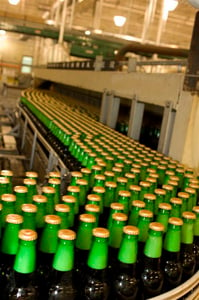
But the Yuengling Brewing Company, founded in 1829, has gone head-to-head against the Goliaths of beer making—and tasted victory.
Andrew Jackson had just moved into the White House when German braumeister David G. Yuengling (pronounced “ying-ling”) opened his brewery in Pottsville, a coal mining town 90 miles northwest of Philadelphia. Five generations later, the company is still family owned, now run by Richard L. “Dick” Yuengling, Jr.
Yuengling's brews have been toasted by President Barack Obama, and they've gained a devoted regional following. In 1987, noting the growing popularity of microbrews, Dick Yuengling re-introduced Yuengling Traditional Lager, a beer more full-bodied than national competitors offered. Walk into a Pennsylvania tavern today, ask for a “lager,” and the bottle set down is likely to say “Yuengling.”
From that home base the company has expanded, distributing its seven brews up and down the eastern United States. In 1999 Yuengling acquired a 40-year-old Stroh's brewery in Tampa, Florida, then in 2001 opened a second Pennsylvania brewery near Pottsville. Yuengling is now the seventh-largest brewer in the United States.
A really lean company
Electrical Supervisor Bill Friedman has worked at the Tampa plant since 2000. The Yuengling maintenance team of nine mechanics, plus Friedman and two other electricians, led by plant engineer Santo Lazarra, keeps the vintage facility brewing and bottling up to a million barrels of beer yearly. Ironically, brewing a product people use for end-of-day relaxation has its own tensions. It takes a very lean operation to win against mega-brewers many times Yuengling's size.
That suits Yuengling just fine. Frugal and no-nonsense, Dick Yuengling describes himself as a “production guy,” according to The Wall Street Journal. Yuengling's 250 employees produce as much beer as the 700 employees at a major competitor. The Yuengling formula seems to be working. The paper reported that Yuengling sales grew 12 percent, to two million barrels, in 2009—the only double-digit growth rate among the 10 largest US beer suppliers
Dick Yuengling “runs a really lean company,” said Friedman. “He doesn't have a lot of overhead as far as management. Here in the brewery you walk around—there used to be maybe 30 offices here [under Stroh's], and 20 percent of those are occupied.”
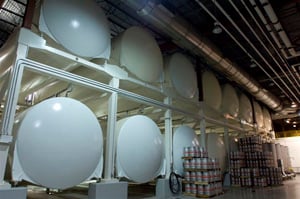
In a plant that's now more than 50 years old, maintenance “is a constant battle,” Friedman said, “although here in the past three or four years we've been investing some money in a lot of good improvements. We just got a new bottle packer that puts it in the 12-pack, and we are now putting in another packer that can do the fridge packs and 24-packs, what we call the suitcase packs.”
A preventive maintenance (PM) approach might seem ideal in such an older facility. “It sounds good and looks good on paper, but you really don't have the manpower to do a PM program,” Friedman said. “While we definitely do PM on the crucial machines, we have limited resources and as a result, a lot of the time we spend in work out in the field is repairs. It's just time for the bearing to wear or the motor to go.”
What is a “crucial machine?” The brewery powerhouse is crucial, where gas-fed boilers produce steam that supplies the brewing kettles and pasteurizers. “If the powerhouse goes down, the whole plant goes down,” Friedman said. Air compressors powered by 150-hp motors supply the plant with air at 120 psi, used to clean kegs before filling. Any device that could fail and affect product quality is also considered crucial.
See what's in Yuenglings toolbox »
“That's a lot of money...especially if you're wrong”
To keep these machines online, Friedman relies on Fluke test equipment, including thermal imagers, a wide array of electrical test tools, and the new Fluke 810 Vibration Tester.
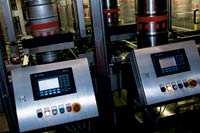
“One of the things I try to do on a regular basis is thermal imaging,” Friedman said. “I use it on our major equipment—our ammonia compressor or our mash tub agitator, a huge mixer that stirs the ingredients. Obviously heat is a good indicator of impending failure on the motor bearings, and on the gearbox itself. Even on water tank levels, if I don't know what the level is and I just want to spot-check against our instruments, I'll use the thermal imager.”
The imager spotted trouble recently in the 75 hp motor powering a positive displacement blower that transfers spent grain 250 feet to a storage silo. “We were having sporadic issues with it,” Friedman said. “I got a thermal imager and I could see that the motor was just running way, way too hot—about 230 degrees.”
Friedman used his Fluke 1735 Three-Phase Power Logger to check the machine's performance. “Because it is a positive-displacement pump, if you know the amount of current draw and the speed that the blower is running, it should be putting out a constant amount of pressure,” he said. “If it's not, then you have a problem. Comparing those factors we could see that we weren't getting the output we should.”
A follow-up test with the Fluke 810 vibration tester identified a bad bearing at the free end of the motor, so Friedman changed out the motor. But problems continued. “When you have two pieces of equipment that are bad, which one is it—is it the blower or the motor?” Friedman said. “It's a chicken and egg situation. After we knew the motor was good, because it was new, we put the 810 on again and it showed that the drive end bearing of the blower was bad.” The issue became one of confidence. Could the 810 be trusted?
“The blower is massive—you can't just say we'll change it and see if it works, because it's not a five-minute job,” Friedman said. “You're looking at five to eight hours of downtime and that's a lot of money...especially if you're wrong. So you have to be pretty confident in your analysis.” The blower bearing was indeed bad, and caused vibration that in turn had damaged the motor.
Calibration times 250
The brewery's 100 large electric motors aren't all Friedman focuses on, of course. Process control at the plant depends on the accuracy of some 250 instruments. “Instrument calibrations, we're proactive about that, instead of waiting until the instrument is way off—it's too late at that point,” Friedman said.
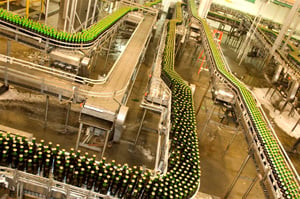
“We use the Fluke 744 Documenting Process Calibrator. That is just a great, great tool that I use extensively,” he said. “It will hook up to a Rosemount or any instrument that is Hart-compatible, that communicates via Hart, which is an instrument protocol. You can view the device's parameters, change the device's parameters. Some devices have a self-diagnostic that you can check the electronic circuitry with, all through this interface. You actually see what the instrument is reading, if it's temperature or pressure.
“From a calibration standpoint we isolate the instrument from the plant process and hook a known constant up to it, like a known pressure. I have Fluke's 700PTP-1 pneumatic test pump. So I'll pump that up to say 100 psi or 20 psi and make sure the instrument is reading exactly that. If not, I have to make some adjustments.”
Friedman also watches over the plant's extensive industrial Ethernet network, using Fluke Networks test instruments to ensure cables and other network elements meet industrial requirements for quality and reliability.
This label spells trouble
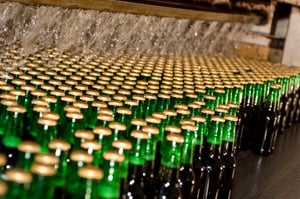
A labeling machine is a complex device, and trouble can be hard to track down. “We were having problems with the labeler and it was hard to pinpoint. It was just sporadic problems,” Friedman said. “I just took the Fluke imager out there and shot underneath, where the rotating parts were. It stuck out at me like a sore thumb: the gearbox was over 200 degrees,” he said. “The gearbox was full of water, not lubricant. The seals on the gearbox went, so water was able to penetrate. We changed the gearbox out and all was fine.
“We use Fluke tools, they help us out a lot,” Friedman added. “They're good quality tools and they help us solve problems and that's the bottom line.”
Waiter, another round of Yuengling lagers! How Yuengling Makes a Better Brew
Milled, heated, cooked, pumped, cooled, aged, and filtered—beer and its ingredients are on the move throughout the production process.
- Corn grits and malted barley are transferred to the hoppers. The malted barley is milled to the desired size. The corn grits and part of the malt are combined with water in the grits cooker to be softened and liquefied, the rest of the malt is combined with water in the mash tun, the "cooker mash" is added to the mash tun, and the mashing cycle is complete.
- The liquid (now called “wort”) is separated from the grains. The wort is transferred to the kettle, boiled for sterilization, and hops are added. The boiled wort is then pumped to the hot wort tank and cooled.
- As the wort is transferred to the fermentation cellar, pure cultured Yuengling yeast is added. The yeast converts the sugar in the wort into alcohol and carbon dioxide, while imparting its own special flavors. When the wort has fermented, it is called "beer." The yeast is reclaimed for the next generation of brews, and the carbon dioxide is reclaimed, purified, and later injected back into the beer.
- The beer is pumped through a centrifuge to increase clarity and then cooled to 32 °F (0 °C) before being transferred to the aging cellar. The beer ages for 14 days to increase clarity and allow the flavor to mature.
- The mature beer is cooled again and filtered for clarity, and the carbon dioxide adjusted to insure superior flavor and foaming qualities before the beer is moved to the finishing tanks.
- The beer is then put in bottles, cans, or kegs for customers.